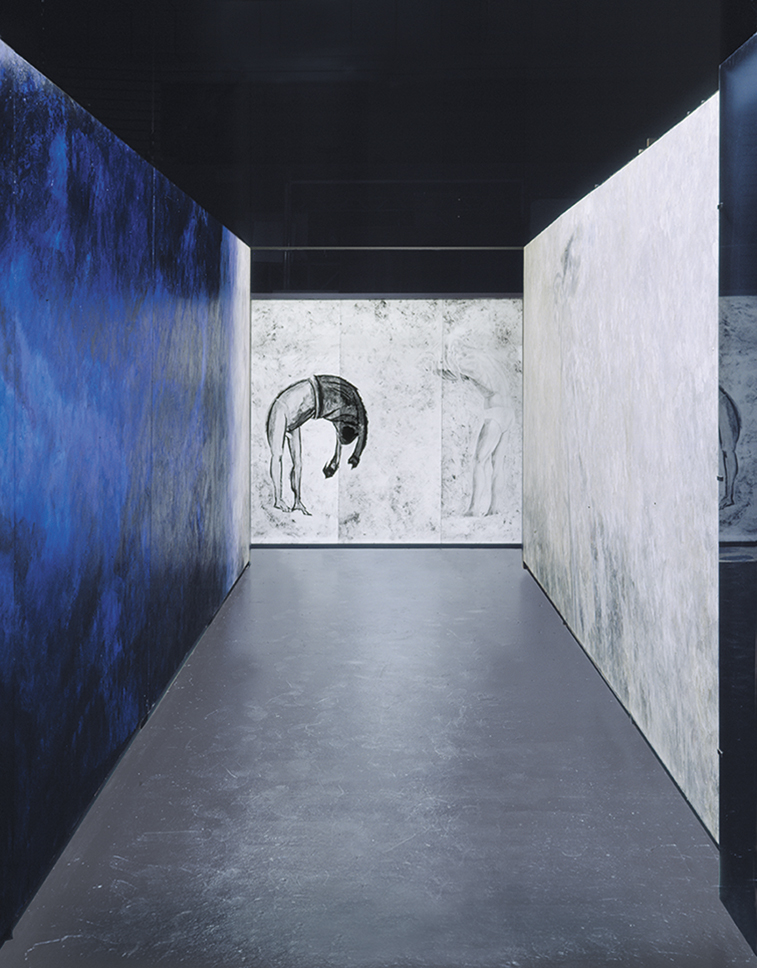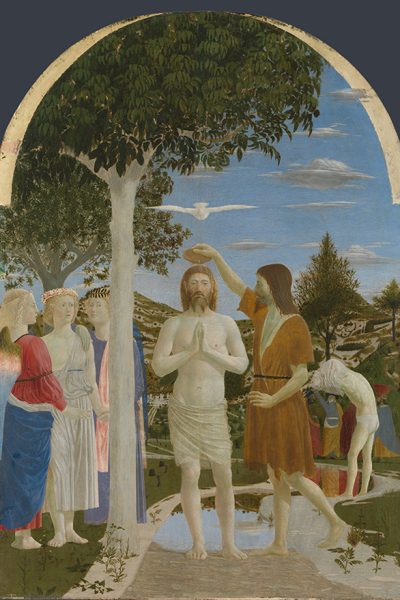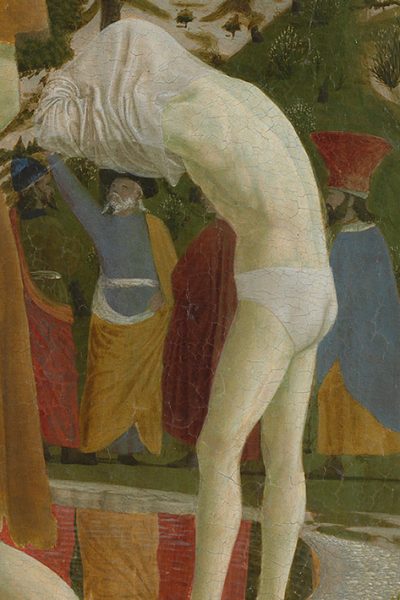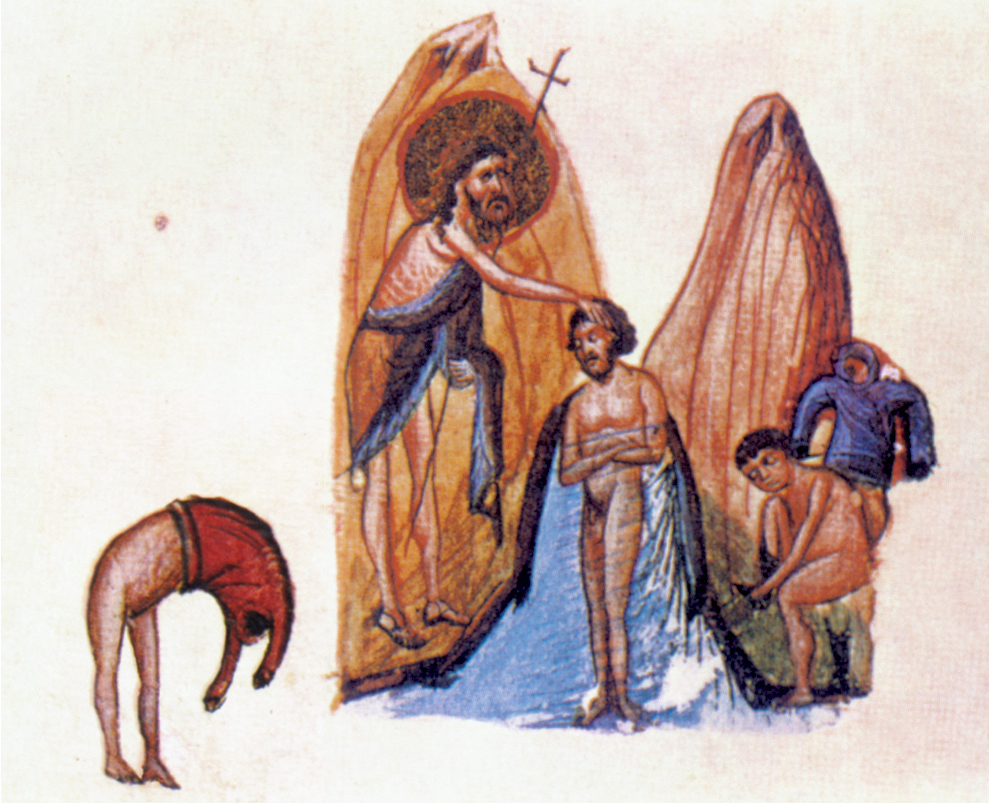Officinae Pictorum/circa 1221, 1985-1987, installation of variable dimensions, acrylic on wood, plexiglass, iron, black and white photography on wood
At the onset of the final two troubled decades of the 12th century, a man was born in Constantinople who was destined to pursue a tempestuous artistic career.
After the death (1180) of the “enlightened” “pro-western” despot Manuel Komninos, his French wife acts as guardian to the underage Alexios, who is overthrown by the “slayer of latins” and “populist” Andronikos. The feuds eventually bring to the throne (1185) Isaakios Angelos. The dynastic intrigues of Byzantium which contribute to the first capture of the “Polis” (1204) by the wildly shouting hordes of crusaders are well known. Among those who profited most from the capture were the Venetians who had already (as early as 1082) obtained from the Byzantines a chrysobull of commercial tax exemption in the territory of the empire.
The then 25-year-old painter arrives at the “Bride of the Adriatic Sea” on his quest for a better fortune in the West, having abandoned forever the torn asunder mighty empire of yore. He has been trained in the workshops of the painters of the “royal city”, whose best preserved samples of art can be seen at St. Panteleimon’s of Nerezi in the Republic of North Macedonia (1164). In Venice, he will see the mosaics at St. Mark’s and will be involved in the reconstruction (1209) of the celebrated “Pala d’Oro” still adorning today the temple’s iconostasis (even if it does so in the gothicized form lent to it by Giovanni Boninsegna in the 14th century). And when the terrible Pope Innocent III (1198-1216) and his less important successor Honorius III (1216-1227) invite artists from Venice to come and work at St. Peter’s in Rome and at St. Paul’s “outside the walls”, this painter will be among those who answer the call.
The necessity to restore the prestige of the Catholic Church turns Rome into a single construction site. It is in this artistic environment, where the influences of the “sentimental” art of the Comnenoi ‒rather than those of rigid Byzantine classicism‒ mingle with the need for a monumental propagandist fresco painting often harking back to the artistic achievements of the Roman past, that the painters of the “Roman School” evolve. This tradition had already been cultivated at St. John’s in Porta Latina and in the early works of Santa Maria in Travestere.
In 1221, when the Crusaders met with total defeat in Egypt and a new Latin Emperor is crowned in Constantinople, “our” painter, by now fortyish, has settled permanently in Rome as master of a workshop with many apprentices.
None of his works nor those of his disciples have been preserved. Nor do we know when he died. But it is from this circle that Pietro Cavallini will spring forth, the man who painted The Last Judgement at Santa Cecilia in Trastevere in the 1290s and the mosaicist Jacopo Torriti who produced The Crowning of the Virgin at Santa Maria Maggiore in the same period. It is in this direction also that Cenni di Peppi, called Bucephalus (Cimabue), will turn when he visits the Holy City (1272). In his turn, Cimabue will pass on his learning Giotto, his star student, he who, according to Dante, was to overshadow his own fame and who, as Cennini writes around 1400, was to transform painting from Greek to Latin. But the tradition carried by the Byzantine painter who travelled all the way from Constantinople to Venice then on to Rome will live on for a long time yet. Its thread seems to have been picked up in the middle of the Quattrocento by the painter from Borgo San Sepolcro, Piero della Francesca, when he paints The Baptism housed today in the National Gallery of London. We are reminded of this by the figure of the Neophyte whose counterpart can be found in an illustrated Byzantine manuscript of the 11th century – no matter how enraged the “toscanocentric” Vasari would be at the suggestion of such a genealogy for Italian Renaissance art.
H. V. – G. H.
George Hadjimichalis, Works 1985-2000, EMST, Athens 2001
SPACE
Installation view at Benaki Museum, 2023




![John Baptising, illuminated manuscript, 11th c., 4.5×4.5 cm, Mount Athos, Moni Dionisiou [Code587, F.13B] George Hadjimichalis - 1221](https://ghadjimichalis.gr/wp-content/uploads/elementor/thumbs/k195T-r2qwn1zjmfj2ba2uimxma7ptylqudwiqbkd60n95kg.jpg)





